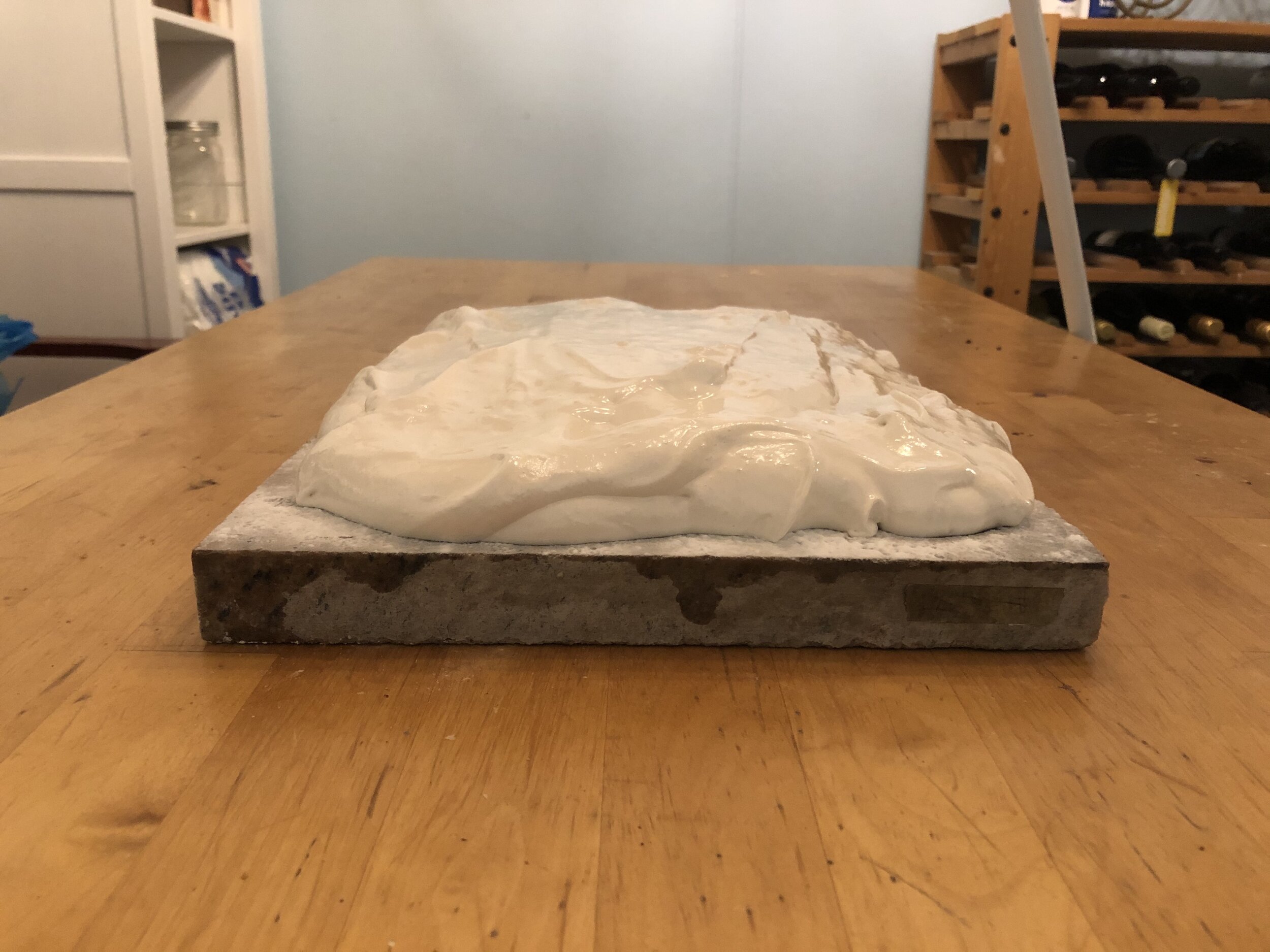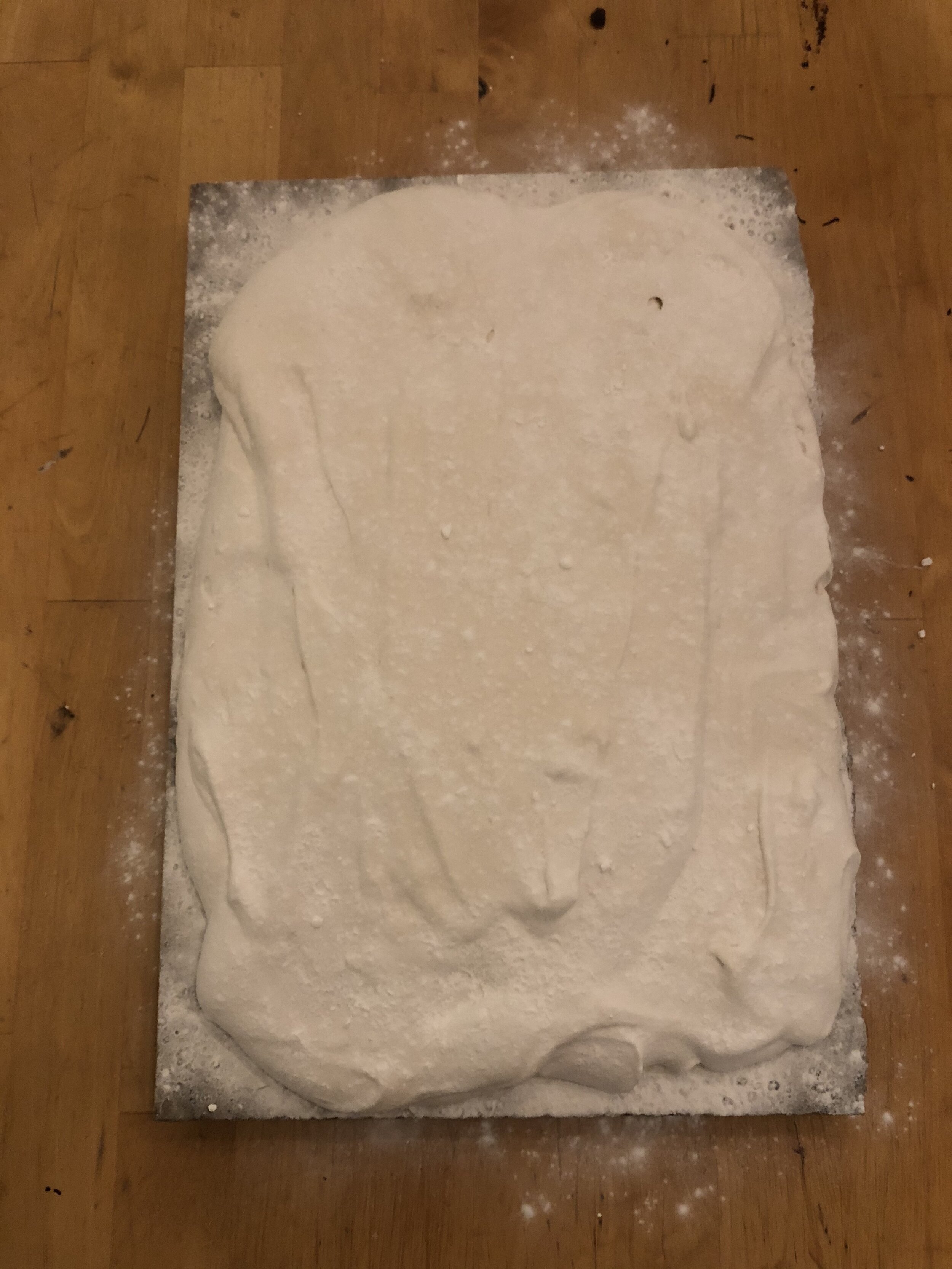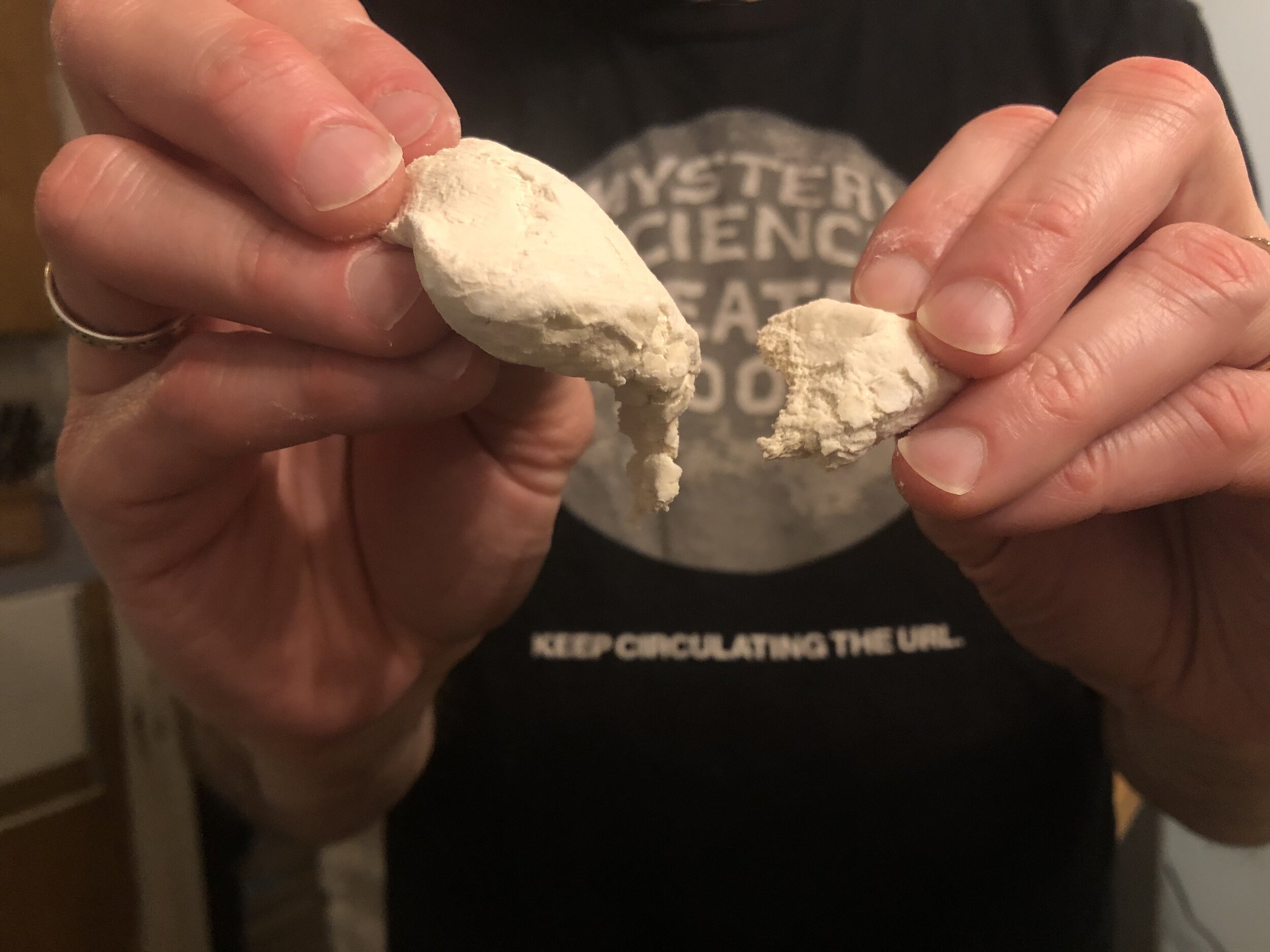The history
In the late 1800s, marshmallow root began being phased out of the recipe altogether and was completely replaced with gum arabic. The marshmallow root had a distinctive flavor that not everyone enjoyed; substituting the more neutral-flavored gum arabic for it led to a cleaner sweet taste (Eléments de Pharmacie théorique et pratique). Additionally, gum arabic produced a similar medicinal effect when it came to treating ailments like a sore throat or cough because it also had mucilage in it. Between the gum arabic and the starch mold mogul marshmallows were almost the perfect confection. There was just one problem: gum arabic was still an expensive product.
Initially, there were no viable alternatives to gum arabic. Gelatin was very popular in cooking due to its nutritional value, especially for the French during the Napoleonic wars (What’s Cooking America). However, during this time, it was a very laborious process to extract gelatin, as it required a lot of boiling and waiting, not unlike the process of extracting the sap from marshmallow root. Gelatin also had a very distinct flavor profile, making it unsuitable for desserts at the time (What’s Cooking America).
This all began to change in 1845 when two different companies developed patents for powdered gelatin. The J and G Company in Edinburgh, Scotland, patented a pre-packaged, unflavored dried gelatin, while American Peter Cooper patented a ‘portable gelatin’ powder (What’s Cooking America). These ready-made—just add water—gelatins were not an initial hit. It took until the end of the century for people to begin using these gelatins and realize their value for desserts.
It wasn’t until 1894 when yet another refined gelatin product was on the market that things finally changed. Charles Knox, of what would become Knox Gelatin, developed refined flavorless gelatin that was produced in sheets (What's Cooking America). This resulted in a superior product, and the use of dessert gelatins began to take off.
In the late 19th century, the concept of “marshmallow” began to be associated with meringue, not the marshmallow plant. By this point, no marshmallow root was involved in the production of the marshmallow candy. Recipes for marshmallow cream, marshmallow frosting, and other such desserts began to show up in cookbooks by the late 1800s, such as this 1895 recipe for marshmallow cake:
Here we can see “marshmallow” is more a reference to the food’s fluffy white appearance and texture than a reference to the root of the marshmallow plant. These recipes are, at their base, meringues.
At this time, marshmallows were being made with less and less marshmallow root, especially in America. By the early 20th century, it was not uncommon to see marshmallows with no actual marshmallow in it at all. Once it was discovered that you could replace the distinctively (and, some would say, offensively flavored) marshmallow root with a flavorless alternative that was also less labor-intensive and expensive to produce, the marshmallow plant was completely pushed aside, and the sweet marshmallow-less confection began its climb into the heart of America.
Marshmallows were reportedly first mass-produced in America by Joseph B. Demerath, founder of the Rochester Marshmallow Company. The Rochester Marshmallow Company began in 1895, pre-dating the marshmallow craze of the 20th century. While it is impossible to say whether this factory was the root cause of the sweet's popularity, it was definitely a contributor. The factory's production, using the starch mogul method, allowed marshmallows to be mass-produced and distributed all over the region, making marshmallows cheaper, and more easily accessible (The Nibble). By the turn of the century, copycat companies were popping up, and marshmallows were being sold as penny candy all over the country. This was one of the first times the confection was being sold exclusively as candy, and not as a medicine.
Americans loved the softy, chewy confection. And once the marshmallow began to gain popularity in the 20th century, their love, which some might deem excessive, began to show through. This was when things began to get weird. The marshmallow started to transform from a food in its own right to an ingredient in other foods, with some genuinely disgusting results, showing up in some distinct recipes that might give modern-day consumers pause.
In a 1913 edition of Table Talk, a cooking magazine, an article by Eva Alice Miller, appeared titled, "Marshmallow Mixtures." The article was about the incredibly versatile things you can do with marshmallows. These ranged from the sweet recipes that almost make sense—marshmallow on half shell (a pear dessert), marshmallow fruit salad, marshmallow almond whip, and the classic toasted marshmallow—to the truly repulsive marshmallow omelet, which as the name describes, is an egg-based sweet omelet (gross).
In 1924, Mary Chambers published Breakfasts, Luncheons and Dinners: How to Plan Them, How to Serve Them, How to Behave at Them—a Book for School and Home. Within the text was a recipe for a shepherd’s pie with a marshmallow crust (even worse). While I have not eaten meat in nearly two decades, I just cannot imagine this was a pleasant combination.
The travesties of cooking didn’t end there. In 1927 with the rise in popularity of marshmallows, the California Lima Bean Council decided to hop on the “disgusting marshmallow recipe” boat. The Council ran ads featuring a dish of baked lima beans topped with bacon and marshmallow, with the promise that “you’ll like them even better served these tempting ways” (seriously, who thought this was a good idea). This was truly a troubled times time for marshmallows and cooking in America.
It wasn’t all bad, though. The same year a marshmallow cultural icon was born. The 1927 book, Tramping and Trailing with the Girl Scouts, featured the first recorded recipe for the “some more,” so named because it leaves the eater wanting some more. The classic recipe of graham crackers, chocolate, and a toasted marshmallow is still a staple in Scouting events, camping trips, and summer campfire gatherings.
The 1930s also saw the rise of another modern-day seasonal American favorite, the sweet potato casserole.
“Marshmallow eventually graduated to the main course. Sweet potato with marshmallow topping still makes annual appearances on thanksgiving across the land. In a 1930s variant, the clever hostess would surround a marshmallow center with a mashed sweet potato patty, roll in crushed cereal flakes, and bake. ”
While this sweet main dish claimed a spot on many American tables, today's version is usually more of a casserole-style. It typically includes cubed, or lightly smashed sweet potato, sometimes with the addition of cinnamon sugar, maple syrup, or nuts, and topped with marshmallows and baked until the marshmallows are soft and golden.
The next great marshmallow manufacturing innovation came in 1948 with the invention of the marshmallow extrusion process. In this process, marshmallow is forced through a tube in the desired form and cut into pieces. The individual treats are usually still coated in starch to allow them to set better and to decrease stickiness. This process allowed production to become even more efficient and is what gives contemporary cylindrical marshmallows their shape. This is the same process companies such as Jett-Puff still use today (Campfire Marshmallows), providing the inexpensive, sweet treat to people across the USA.
Some might define Americans’ obsession with marshmallows excessive. In fact, the 2014 edition of the Oxford Companion to Food does just that.
“[marshmallow] is a versatile substance, which displayed its versatility to maximum (some would say excessive) extent in the USA in the 1930s to 1960s, when it occurred surprisingly often in recipe books, for example as an ingredient for salads, in fillings and toppings for cakes and desserts, and as toasted marshmallows, crisp outside and melting soft within. ”
It is true that Americans’ obsession with the sweet treat is astounding. On average, Americans consume 90 million pounds of marshmallows each year (National Confectioners Association). The town of Ligonier, Indiana even hosts an annual festival entirely centered around marshmallows. The marshmallow is also a treat loved and consumed throughout history and across different parts of the globe. While the confection today is different from its predecessors, its sweet, sticky hold on people all over the world will never cease.
The Recreation
I had lofty aspirations for this recreation. I am vegetarian, and I had dreams of finding a simple, few ingredient recipes for vegan marshmallows, which I could share in triumph with the masses.
That is not what happened.
The modern marshmallow is noticeably different from its predecessors, both in look and texture.
Honey Marshmallow, Pate de Guimauve, Gelatin Marshmallow
While the honey marshmallow candy is dense with just a little chew, pâte de guimuave is noticeably lighter and fluffier. It does, however, retain a bit of its wetness. It pulls apart, and even when coated with powdered sugar, can still be sticky (were I to make it again, I would pipe them individually to allow a skin to form on each piece). It does not hold its form, and when cut can slump. All this in comparison with the modern, gelatin marshmallow-free marshmallow. They are fluffy, yes, but also firm. They squish but break when pulled apart.


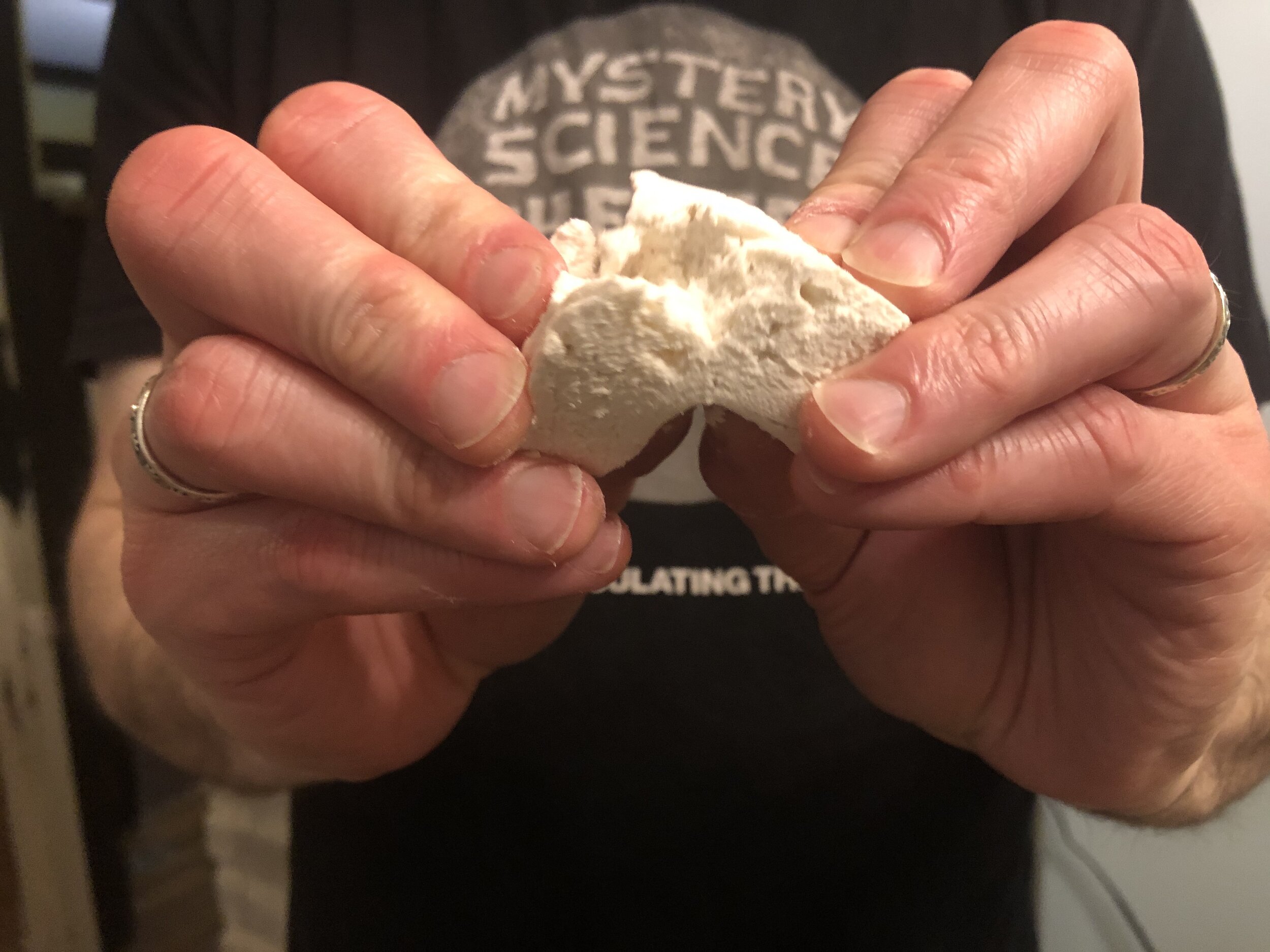




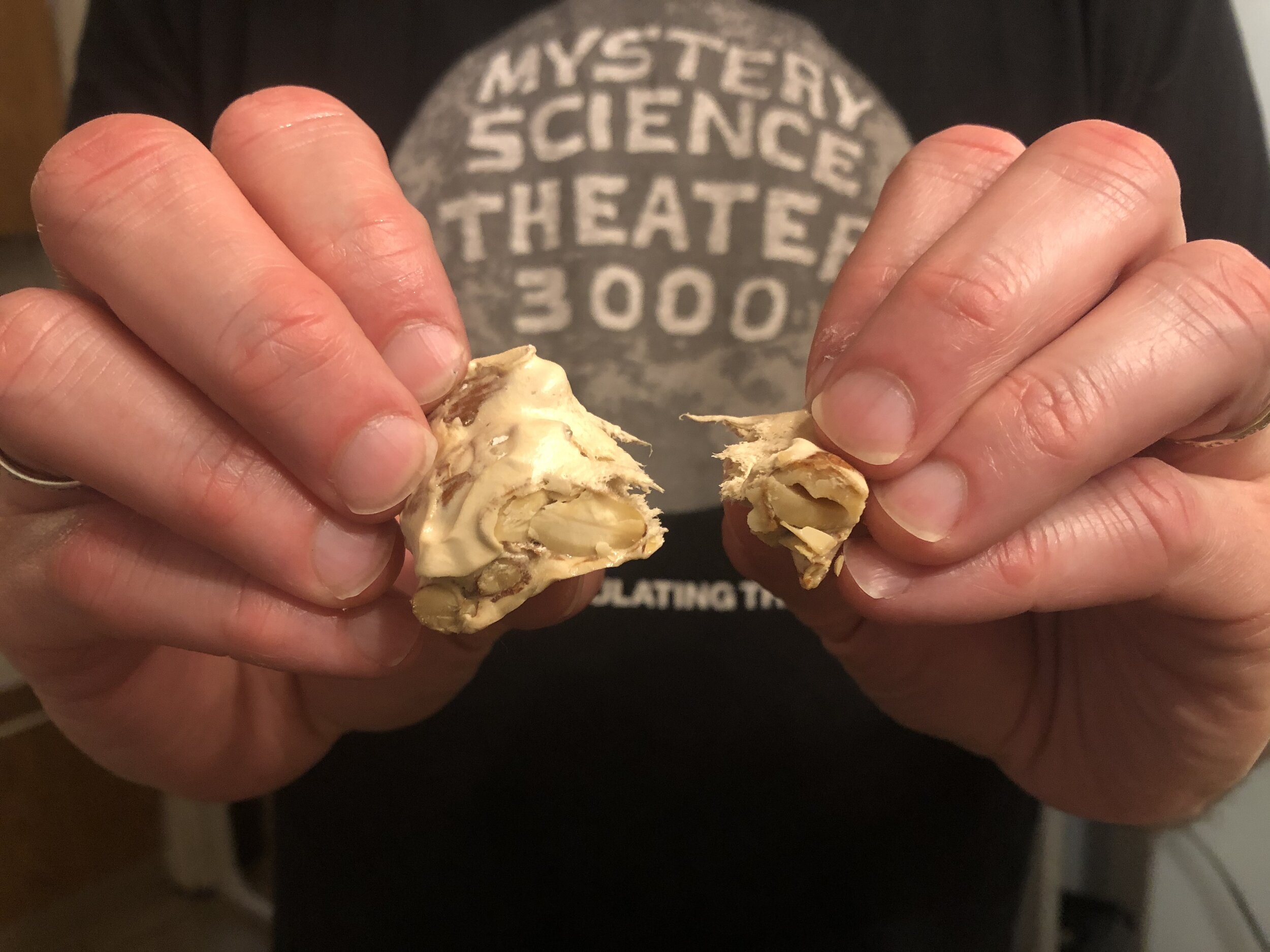

I tried many techniques to achieve this. One was to use the pâte de guimuave ingredients but a modern marshmallow technique (pouring the hot sugar over the egg whites in a stand mixer.) I subbed out marshmallow extract, for powdered marshmallow root. It worked really well and took less time. But you end up with a pate de guimauve style marshmallow, not a modern one. And spending $13 on gum Arabic for each batch is cost-prohibitive.
I next played around with modern marshmallow recipes, subbing in Agar-Agar, to no avail. The agar-agar simply does not have enough hold.
I tried subbing in aquafaba for egg whites and doing a meringue-based marshmallow. Again, it kind of works, but you end up with a dense marshmallow and still need additional stabilizers.
Finally, I was forced to admit it. There is no easy vegan substitute for the marshmallow. Gelatin is the perfect binder. It is a stabilizer and a protein. It takes the place of the egg whites and the gum and does the job better. Unflavored gelatin is truly a marvel of modern food technology. And it is cost-effective. A pack with enough gelatin for two batches of marshmallow only cost two dollars.
That being said, working with gelatin, something that as a vegetarian I have literally never done before and doubt I will ever again, felt more like a science experiment than cooking. When you use gelatin powder, you have to "bloom" it. Soaking it in water to activate it. It takes only a few minutes, and the entire thing turns to a hard gelatinize mass. This is what gives you the base for your marshmallow. I found that when cooking it, I noticed a smell (my meat-eating husband did not). And the mixture before it cooled, seemed unnatural almost like a shaving foam. It was, however, straightforward to work with.
A basic marshmallow is very easy and only contains three ingredients:
Sugar
Water
Gelatin
A pinch of salt and vanilla extract helps round out the flavor as well but isn't strictly necessary.
Once you bloom your gelatin, you mix it and your water and sugar in a pan, bring the contents to a boil on medium heat and cook until your liquid reaches hard-ball stage or until when a spoon is dipped in, a long thread comes out. I thought this part would be more finicky than it actually was. Mine technically never reached hard-ball stage but turned just fine. And I saw many people who barely took theirs to soft-ball and also turned out okay. The forgiving nature of gelatin.
Pour the entire contents into a stand mixer and beat for about 10 min. Pour onto your surface, or into a pan. It will be stiff, so I put a little oil on my hands and patted it down to form a more even hunk.

That's it. That is modern marshmallows. Quick. Easy and relatively painless, though not vegetarian or vegan.
I did find a great recipe for vegan marshmallows, though.
Here is what you do. You go to Trader Joe’s. Go to the packaged goods section. You buy their marshmallows and use those instead. That’s it.
Are there recipes for vegan recipes online? Yeah. Of course. And some are good. But the number of ingredients you need just isn't worth it. Buy the Trader Joe’s ones.
Or make these all sugar gelatin filled marshmallows.
Leaning tower of marshmallow
All sugar marshmallow
This is a simple, easy marshmallow recipe. You will get light, fluffy marshmallows each time.
Cook time: 20 min active, 3 hours cooling
Servings: 24-30 marshmallows
Ingredients
½ cup water + 2 tablespoons Gelatin
½ cup water
2 cups of sugar
Optional:
Pinch salt
½ teaspoon flavoring extract
And/or
2 Tablespoons Cocoa powder
Instructions
1. Prepare a marble slab or baking sheet by sprinkling it with powdered sugar or starch. If using a pan, coating with oil first helps to coat the sides with powder.
2. Combine ½ cup water and gelatin in a small container.
3. In a medium pot, mix sugar and, if using, cocoa powder. Pour in gelatin mixture. Then add an additional ½ cup water. Bring mixture to a rolling boil over medium heat.
4. Boil until the mixture reaches hard-ball stage.
5. Once the mixture reaches hard-ball stage, pour contents into the stand mixer. Beat on low for 2-3 min, then turn up to high heat until mixture has at least doubled. About 10 min.
6. Using a ruby spatula, transfer contents to starch covered surface or pan. If large peaks form and do not level out, put a little oil in your hand, and gently press down to create an even surface.
7. Allow the marshmallow to set for at least 3 hours. Then cut and toss with additional starch or powdered sugar and save in airtight containers.












